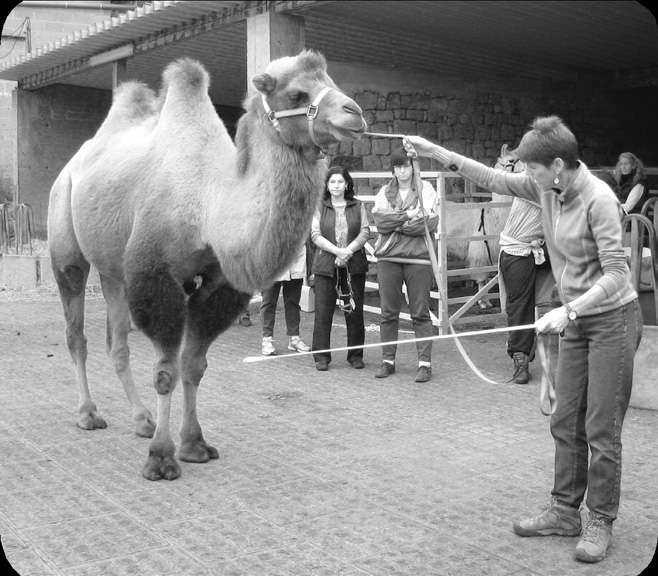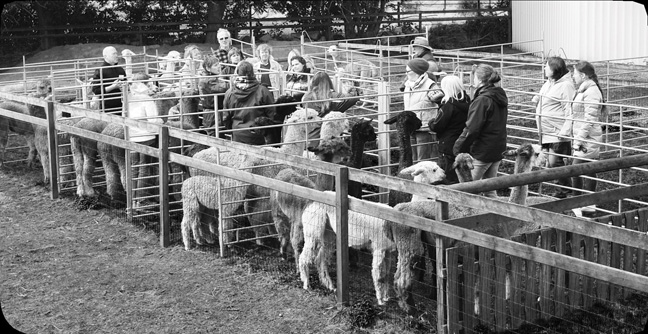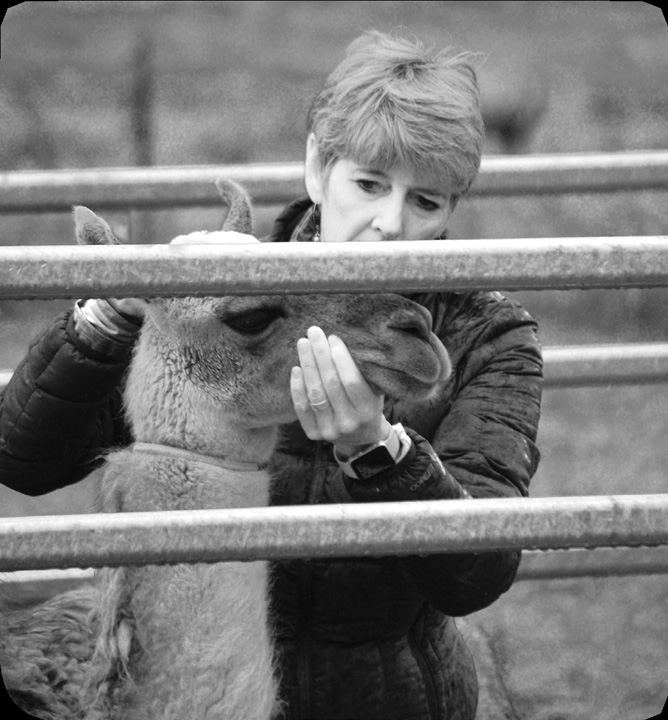Llama and Alpaca Behavior

How do you want life to be with your alpacas or your llamas? Why did you decide to buy llamas or alpacas or both? What kind of relationship do you want to have with your animals? How do you see llamas and alpacas adding to your life? What is important to you about the treatment of animals in our human world?
These larger questions are frequently forgotten in the excitement of selecting and purchasing your first animals. Yet these are the important considerations that will guide you in your decisions about everything from showing to shearing and haltering to hugging.

Llama and alpaca shoppers are often introduced to camelids at a fair or show. There is nothing quite like that first nose greeting, those cute little lips, the eyelashes, that over-the-shoulder look. You are smitten. This alpaca or llama plays kissy face, lets you fondle his wool, pet his head and take all kinds of liberties which the average alpaca or llama would never tolerate. You sign on the dotted line, then find that your huggable investment is viewed closely only with binoculars.
When you get home, your llamas or alpacas hang out at the far side of the pasture and venture over to look at you only if you are safely on the other side of the fence. “Well,” your new camelid buddies fess up, “that other animal you met, that is what we call a ‘Public Relations Animal.’ The truth is most llamas and alpacas are aloof and don’t like to be touched.”
This is called The Way Things Are. The moment you become an alpaca or llama owner you begin to get the “real” scoop on what llamas and alpacas don’t like, what they can do, what they won’t do, and how you—the human—must do things. As a result, after a few months of exposure to The Way Things Are, you accept the limitations others placed on the relationship you thought you could have with your animals. You begin to give up on the dream with which you started.
Let's Not Give Up
It can be the way you imagined it to be in the beginning. Let’s fantasize a moment about a reporter’s findings when he visits to do a news story about your fantasy farm. As the reporter is writing furiously in his notebook, his photographer buddy is snapping away. What kinds of adjectives do you want the writer to use as he describes his experience with you and your animals? What photographic images of you and your animals would you like to appear in the newspaper.?
How about words such as: trusting, fun, kind, companionable, respectful, interesting, harmonious, understanding—even efficient. How about: “I watched mesmerized as these magical animals gathered around visiting politely. These graceful camelids were curious yet respectful. They were shy around me but they clearly trusted their owner. I could sense some special relationship.”
How about a picture of you sitting in the midst of your animals while they relaxed and chewed their cud? How about another photo of you walking through the barn with your alpacas and llamas sitting quietly as you stepped over and around them. These are some of the words and images that my clinic attendees invariably suggest.
The reality for most llama and alpaca owners is decidedly different. A reporter visiting most llama or alpaca farms would more than likely comment, “I was struck by how touchable these animals appeared, but yet how unfriendly they behaved.” Or “Gee, why is it so hard to catch them? Don’t they like you?”
Why do most llamas and alpacas dance away from our reach and interact with us primarily for food? Why do they stand up and look for the exit when we come into the barn? Why won’t they let us touch them? Please don’t believe it is just The Way Things Are.
There is a way to interact with alpacas and llamas that gives them the confidence to relate to humans. This is called The Way Things Can Be (and IS for many alpaca and llama owners). You must learn the secrets of becoming the kind of person with whom your alpacas and llamas will feel comfortable.
The Law of Camelidynamics
What is the SINGLE most useful behavior that you can get your llama or alpaca to do for you on a consistent basis? (Be aware: this is a trick question.)
You walk into the training pen with your animal. What do you want your llama or alpaca to do? What do you want him to do when you put his halter on, trim his toenails, prepare him for a show, look at his teeth, or give him a shot? What one thing are we hoping for when we approach our camelid companions?
The most useful behavior that you can get your llama or alpaca to do for you on a consistent basis is: NOTHING.
You put the halter on. You put the pack on. You pick up the feet. You give the shot. You do the shearing. How much easier it would be if your animal stood quietly doing nothing while you did your work.
What If You Were Picked Up by Aliens?
So why won’t they stand still? Why—when we do so many nice things for them—do they insist on running away unless we lure them with food? Why do we have to chase them, hold them, wrestle them and build chutes? Perhaps it is BECAUSE we chase them, hold them, wrestle them and put them in chutes.
Most of the llama and alpaca management and training that we need to do is not hurtful. Even the occasional shot is really nothing compared to the unpleasant and scary experience of being cornered, grabbed and wrestled into submission. This drama all happens before the needle ever pricks the skin.
Perhaps the best way to understand camelid behavior is to engage in a bit of role playing. Imagine that you are driving down a road late at night. You see a blinding flash of light, get out of the car and walk toward the light. Suddenly strange looking creatures appear. Your first instinct is to run. You are so completely panicked that you run right past your car. The aliens have six legs, compared to your two and are faster.
These strange beings chase you down and grab you. You fight like crazy, but they are too strong. They drag you aboard their space ship. Once on the space ship these alien things wrestle you into a tiny little box. The aliens tie your arms and legs to the box and slip a strange contraption around your neck.
You continue to struggle, but there is no use. Next one of them puts his slimy hand thing on your leg and slowly slides your pants leg up. You freeze, hold your breath and then finally scream. After all that struggle, wouldn’t it be odd if the aliens did nothing more than look at your feet and then let you go free?
To an alpaca or llama, I think we must seem very much like the aliens I just described. Once we’ve captured our creature the procedure usually isn’t all that bad, but the process of getting them within our grasp is horrendous.
A camelid’s first line of defense is most always, like ours, the flight response. If running is no longer an option, they struggle to get free-the fight response. For llamas and alpacas this tactic includes leaping, screaming, spitting, spinning, and throwing themselves around and against the attacker. Thankfully camelids don’t generally resort to biting, but they can.
If all attempts to get away are exhausted most animals will get very still. This is not acceptance of the situation but rather another instinctive response—the freeze response. The freeze response is often accompanied by kushing and, in extreme cases, a loosening of the bowels and bladder. I didn’t want to get too graphic in my spaceship example, but humans would have many of the same responses.
What would cause a llama or alpaca to abandon these instinctive maneuvers and maybe even visit with us? Let’s go back to the alien example. Fear of the unknown is perhaps the most potent of all fears. An inability to communicate their intention is what makes the aliens so frightening. Learning the alien's language and ultimately its culture makes an alien environment understandable and safe. If we can devise an approach that does not feel alien to an animal, we will become a safer presence.
The secret to understanding Camelidynamics is in learning how llamas and alpacas think and react as well as understanding how your behavior affects the behavior of the animal. This is the path to enhanced communication and understanding. Your llama or alpaca then will overcome the instinct to run from you. Understand Camelidynamics and magic happens...your llama or alpaca will stay still, hang around you and DO NOTHING.

How things go wrong
Let me give you a very telling example of a common misunderstanding I see at llama and alpaca farms all over the world. A new camelid owner has just purchased five new animals. The new owner is now going to make friends. The following scenario is told from both the animal and the human point of view.
Humanthink: I want my llamas/alpacas to like me, get used to me and allow me to touch them. They will only come to me for food so I will put out the food in the barn feeders and call the critters. I will touch them on the back as they enter the barn and as they line up at the feeders. I will cruise around the barn and pat everybody while they eat. If I do this every day, they will eventually like me and trust me. I will have made friends with them and made great strides in my training program.
Camelidthink: Gosh, I’m hungry and I sure would like to go in there in get that food, but that scary thing is standing right in the @#%!& doorway. I hate having to deal with this to get to the food. Maybe I’ll just wait until it leaves, or maybe I could rush through the door really fast and it won’t be able to get me. Maybe I could kind of slink down a bit as I rush through the door and it will miss. Oh, all right I will make a dash for it! I made it. But now it is stalking around in here while I am trying to eat. What a royal pain all this patting is! At least I can kind of fishtail around here by the feeder and get a bite here and there while I am avoiding the thing.
Following this line of logic many llama and alpaca owners unwittingly teach their animals to rush head-long past them for fear the dreaded arm may reach out and touch or grab them. Even worse new owners may teach their animals never to come in the barn when the human is there.
Camelidthink: People who reach out, chase, corner and grab camelids around the neck are not safe to be around.
Llamas and alpacas can get used to almost anything. Establish a routine, and camelids will eventually tolerate touching. While this kind of behavior may result in toleration, it seldom results in affection. This book is about something much more than toleration. I am writing this book to help you create a truly respectful, safe and trusting relationship with your animals.
From my experience I’ve found you cannot buy this kind of relationship with food. You cannot produce it with repetition. And you cannot get it by overpowering an animal. You create this respect, safety and trust by learning to think like a camelid, working consistently to make them feel safe, and learning to honor their nature.
I have learned these things in my years with llamas and alpacas. Consequently I can accomplish things almost immediately with an animal belonging to someone else; things that the owner—despite a prior relationship with animal—cannot do. Animals that have never allowed a person to touch their head and mouth, or pick up a foot, or give them a shot without a big fight, will let me do it—easily.
After reading this you may think the approach makes a lot of sense and have a desire to learn the techniques I call Camelidynamics. The next thought you have might be: “What about the animals that I have already chased, grabbed, wrestled, and frightened?” Will they change? What if I have older animals that have been handled the old way for their whole life? The answer to the question “Will they change?” is OF COURSE THEY WILL! Animals (and humans) never stop learning.
In order to stay alive animals must react and adapt to changes in their environment which includes changes in the behavior of their humans. Think about it…someone sells an older llama or alpaca. This animal arrives at his new home and must immediately figure out where the food, the water, the minerals and the pastures are. They must discover if there are any ditches or other dangers in their environment. He or she must create new alliances with other animals AND figure out how the new humans do things.
The learning process never stops. My 90 year old mother moved into an assisted living community and had to do essentially the same thing. If you embrace the collection of ideas and techniques I call Camelidynamics you will find that your animals regardless of their age and experience heave a sigh of relief and embrace the new you!
I am no “camelid whisperer.” I just know how to speak and understand plain ol’ llama/alpaca language. I speak with my body and my behavior, and I do it meaningfully and clearly. And the best news for you is you can learn these same skills. I can teach you how. Contact me on my website.
Like this article? Become a RMLA Member today!

